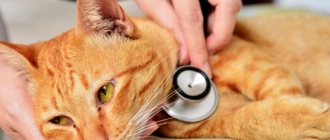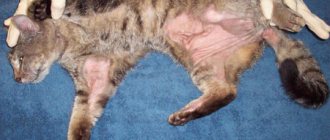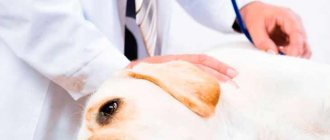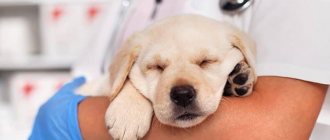Pulmonary edema in a cat or acute pulmonary failure is not an independent disease, but a complication of certain ailments of a cardiogenic or non-cardiogenic nature. It is accompanied by acute suffocation, progressing as the swelling increases. If veterinary care is late, the animal dies from asphyxia. In the article we will look at the causes of pulmonary failure in animals, answer the questions: why the disease is fatal, whether the pathology can be cured, what preventive measures exist.
What it is
The process of breathing in animals, as in humans, occurs with the participation of alveoli - peculiar bubble formations in the lungs, intertwined with a network of blood vessels. Under normal conditions, the alveoli of the lungs during inhalation are filled with oxygen entering the blood, which then carries it to the brain, nourishes the heart and tissues. When you exhale, exhaust air containing carbon dioxide is released through the alveoli.
In pulmonary insufficiency (edema), for various reasons, transudate (edematous fluid) and the liquid part of the blood enter the alveoli - infiltration. A sharp decrease in the working volume of the lungs disrupts the breathing process and leads to progressive oxygen starvation of the body.
Complications and prognosis
Pulmonary failure in cats is characterized by a rapid progression. Symptoms appear within one day. According to the Moscow Veterinary Academy, signs can develop within 2-3 hours. The cat tries to breathe in air, but she can’t. Without timely intervention, this can lead to death due to the development of oxygen starvation, which is accompanied by such deteriorations: impaired blood circulation in the brain, cardiosclerosis, ischemia.
With such a pathology, the animal must be urgently shown to a specialist to provide emergency care.
It is also highly undesirable to rehabilitate a cat at home, since only specific medications can relieve swelling. You need to understand that the pathology will not go away on its own, and the sooner the animal owners see a doctor, the greater the chances of recovery. The prognosis is not always favorable. Since the development of the disease does not last very long, most veterinarians say that edema is a dying condition of the animal.
Causes of the disease
Pulmonary failure in cats almost always develops as a complication of heart disease, but it can also have a different, non-cardiogenic nature.
Cardiogenic pulmonary edema
The most common cause of pulmonary edema is progression of heart failure in cats. Heart failure develops due to disruption of the left ventricle of the heart. This provokes pathology of the pulmonary circulation and swelling in various organs and tissues, including the lungs. Cardiogenic edema accompanies the following diseases:
- cardiomyopathy;
- aortic insufficiency;
- mitral stenosis of the heart;
- pulmonary embolism;
- myocarditis;
- hypertension;
- infective endocarditis.
Cardiogenic pulmonary edema in cats is characterized by a gradual filling of the alveoli with fluid, an increase in oxygen starvation of tissues, turning into asphyxia. In this case, in order to save the animal, resuscitation measures cannot be avoided.
Non-cardiogenic edema
Infectious and non-infectious ailments that may be complicated by pulmonary insufficiency are:
- diseases of the respiratory system: pneumonia, bronchial asthma, tuberculosis, chest injuries, inhalation of volatile toxic substances;
- diseases of the excretory system: nephritis, renal failure;
- Gastrointestinal diseases: pancreatitis, intestinal obstruction, volvulus;
- diseases of the nervous system: encephalitis, meningitis, brain tumors, reaction to anesthesia after sterilization or castration;
- complications of infectious diseases: influenza, inflammation of the upper respiratory tract, plague;
- severe allergic reactions.
Predisposition to disease
Pulmonary edema of a cardiogenic nature more often occurs in cats of certain breeds that have a hereditary tendency to cardiovascular pathologies. This breed defect is inherent in many artificially bred cat breeds:
- sphinxes;
- Maine Coon;
- the British;
- Scottish Fold;
- Persian and representatives of other breeds.
Kittens more often suffer from traumatic pulmonary edema. The pathology develops in them after chest injuries, to which they are very susceptible.
There is no difference in the incidence of this pathology between males and females.
Forecast
Pulmonary edema in cats is a very dangerous condition that develops rapidly and can be fatal.
Cat owners should be prepared for such developments and understand that in this case time is everything.
The sooner a cat is shown to specialists, the sooner it receives first aid, the higher its chances of survival.
In a hospital setting, there are all the necessary tools for diagnosing and assisting an animal: x-rays, an oxygen chamber, injections and medications.
Competent intensive therapy at the initial stage of the disease is a guarantee of success. It is unacceptable to treat pulmonary edema on your own - it can kill your beloved pet.
Types of disease
Based on the rate of progression of symptoms, several types of disease are distinguished:
- Lightning fast - has rapid development, leading to rapid death.
- Acute - characterized by a high rate of development. Symptoms increase over several hours. In this case, prompt treatment is the only way to save the animal.
- Subacute - has a wave-like development. Periods of increasing symptoms are followed by periods of subsiding.
- Protracted - has erased symptoms. Characteristic of chronic pathologies.
Symptoms of the disease
In cats, symptoms of pulmonary edema include signs of oxygen deprivation. Their onset may be preceded by a characteristic state of the animal, indicating a deterioration in health. This is anxiety, hoarse cough, refusal to eat, pallor of the mucous membranes.
With an increase in oxygen deficiency in the tissues, the animal begins to suffocate. The state of lack of air is determined by the specific behavior of the cat:
- heavy breathing with an open mouth and protruding tongue;
- a position in which it is easier to breathe: paws widely spaced, neck elongated and head lowered;
- cold paws;
- bluish mucous membranes of the lips and nose;
- abdominal breathing.
First aid before going to the veterinary clinic
If there are signs of pulmonary edema, immediate assistance to the animal is very important, since it determines whether resuscitation will be successful. Before delivering the cat to the clinic, it is necessary to make the breathing process as easy as possible for her using improvised methods:
- give an injection of a diuretic (Furosemide);
- open the windows or take the cat out into the fresh air;
- provide the animal with complete rest and limit physical activity;
- do not disturb or take any forceful action towards him;
- deliver to the clinic as quickly as possible;
- During transportation, it is advisable to place the animal on its side.
If first aid is provided correctly, then subject to a professional approach to the choice of treatment method, there is hope that the animal will recover.
Diagnosis of the disease
Diagnostic procedures should be as prompt as possible, since suffocation can progress rapidly. Sometimes it is advisable to start treatment procedures in parallel with diagnostics, so as not to miss time. Basic diagnostic measures:
- A detailed survey of the owner about the behavior and well-being of the animal since the moment of illness.
- External examination and auscultation (listening) of the lungs and heart.
- X-ray examination of the chest. Based on the pulmonary pattern, one can determine the nature of the pathology, since areas of the lungs that do not take part in the breathing process and the level of fluid in the alveoli are visible. Pathological changes in the heart muscle are also determined. X-rays also help to carry out differential diagnosis, which makes it possible to separate the disease from other pathologies of the heart and respiratory system.
- Ultrasound of the heart is prescribed if a cardiogenic origin of the disease is suspected, to determine how much the contractility of the left ventricle is altered.
- An electrocardiogram provides information about the presence of ventricular hypertrophy, arrhythmias and ischemia of the heart muscle.
- A general and biochemical blood test will complement the picture of the disease with a number of clinical signs.
Prevention
Preventing the development of the disease involves monitoring the health of the animal. This especially applies to cats with weakened immune systems and breeds that are more susceptible to edema. It is these sick animals that should be checked by doctors every six months. The animal must be kept in comfortable conditions with a favorable temperature. Excessive physical activity should not be allowed. It is also important to give your cat the necessary vitamins and vaccinations. It is important to treat the original source of the disorder so as not to provoke a relapse.
Treatment of the disease
Treatment of pulmonary edema begins with resuscitation measures designed to support the cat’s life. First of all, this is oxygen therapy, which consists of forcing the cat to breathe through a special mask where oxygen is supplied or placing it in an oxygen chamber for a certain time.
If the cause of pulmonary insufficiency is a foreign body or vomit entering the respiratory tract (aspiration), then they are removed by tracheostomy (extending the trachea).
The main treatment consists of drug therapy:
- getting rid of swelling and excess fluid in tissues - diuretics, diuretics (Furosemide);
- normalization of heart function - drugs that relieve heart failure and affect tissue metabolism (Carboxylase);
- decreased pressure in the pulmonary circulation - ganglion blockers (Bromide, Trimetaphan);
- stimulation of breathing - drugs that stimulate the parts of the brain responsible for breathing (Sulfocamphocaine);
- relieving inflammation - antihistamines (Dexamethasone);
- If pulmonary edema occurs in a cat due to a bacterial infection, then treatment with antibiotics is started.
After the acute condition has been relieved, therapy for the underlying disease begins, during which medications of various types are used, according to indications, depending on the nature of the disease.
Treatment of pulmonary edema and associated diseases should only take place in a hospital, since the serious condition of the animal requires constant medical supervision.
Prognosis for pulmonary edema in a cat
The prognosis for animals with this diagnosis varies significantly and depends on the reasons that led to this condition. In cases of non-cardiogenic pulmonary edema, it is necessary to identify the etiological factor and carry out appropriate treatment, because in some situations, the use of diuretics may be useless and therapy should consist of the correct choice of infusion drugs. In these cases, with correct diagnosis, the prognosis for patients can become optimistic. With cardiogenic edema, the prognosis directly depends on the severity of the disease. According to statistics, if symptoms of congestive heart failure have manifested, then the animal's life expectancy is about 18 months from the onset of symptoms. But thanks to modern approaches to therapy, it is possible to significantly improve the quality of life and the likelihood of early development of life-threatening symptoms for patients with heart failure.











